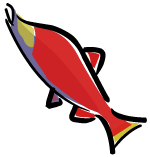
Sustainable seafood is caught in ways that can be practiced now and in the future, without jeopardizing the survival of any species or the integrity of the ecosystem.
The Alaska state constitution mandates that all fish—including salmon—shall be managed for sustainability. As a result, the entire Alaska seafood industry follows precise management guidelines and laws, ensuring that the fisheries are at once productive… sustainable… clean… and healthy.
Effective resources management, reliance on scientific research, and conformance to relevant international standards, such as those of the United Nations Food and Agricultural Organization, (UN FAO) further prove Alaska’s leadership in sustainable fishing.
The needs of the harvest are balanced with the needs of the ecosystem
with a harvest policy known as “salmon escapement”.
During spawning season, salmon are observed and counted as they head upstream to spawn. By making sure a sufficient number of salmon complete the journey, state fishery managers ensure an ongoing, self-replenishing supply. It’s only after enough salmon have returned home that the fishing season opens. And even then, the number of fishermen allowed to participate, and the size of the catch, as well as fishing methods, are strictly regulated to ensure an ample supply remain to feed the robust populations of bears, eagles and a variety of other mammals and birds. The vast numbers of these animal populations are testament to the success of Alaska’s salmon management practices.
And, unlike species in other parts of the world, no Alaska Salmon are threatened or endangered.
Alaska’s proven track record of responsible management extends over half a century. It’s these management practices that keep the world well-stocked with a continuous, ever-replenishing supply of wild salmon and makes Alaska a world leader in sustainable fisheries.
|




